Conversations with Collectors: The Markey Canadiana & Folk Art Collection
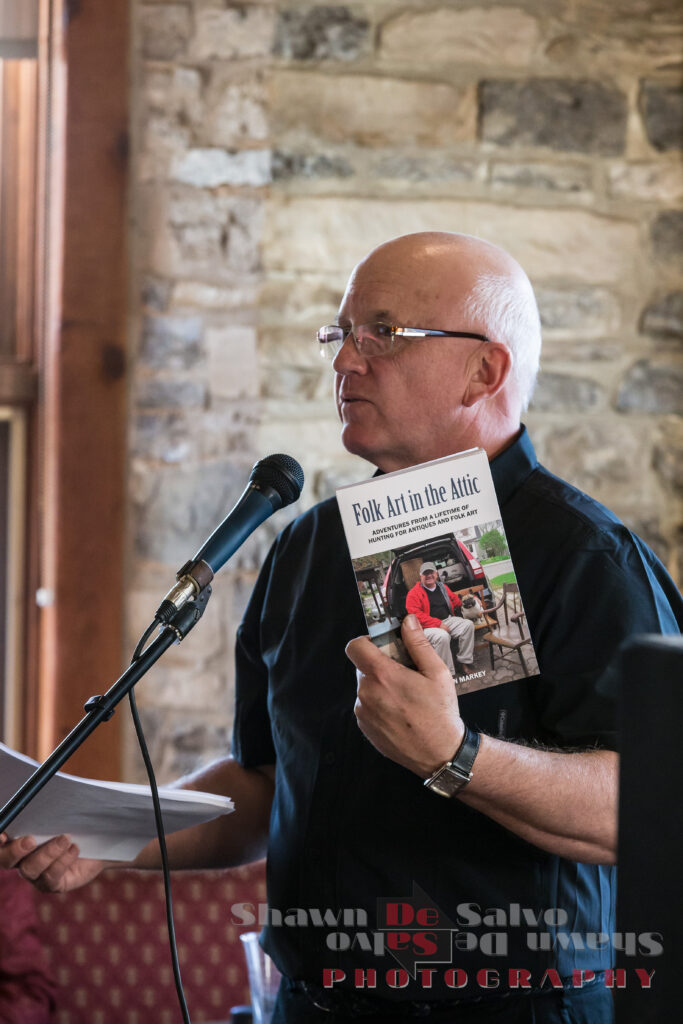
Shaun and Joan Markey have been collecting Canadiana and Folk Art for over forty years. They began their collection in 1980. Since that time, they have enjoyed every aspect of collecting including the many friends and acquaintances they have made along the way. Shaun documented a great many of their collecting adventures in two books he has written: Folk Art in the Attic and Antique Memories. He has written on the subject of antiques and folk art for Maine Antiques Digest, Canadian Antique & Vintage, and several other publications. In 2019, Shaun also hosted and produced a six-part television series for Rogers Television in Ottawa. In addition to writing, Shaun has also given many talks and media interviews on collecting antiques and folk art.
As much as Shaun and Joan have enjoyed assembling their collection, they knew at some point it would be time to let go, to let other collectors acquire the objects they’ve had in their possession for so long. After 43 years of collecting, the time seemed to be right to let most of their treasures go to new homes. To commemorate this moment, Shaun recently wrote an article sharing what originally sparked his passion for antiques and folk art. Enjoy a sample of that story here:
“…my interest in the past had been restricted to studying family history. The interest in genealogy and antiques merged on a cold November day, when I tracked down the location of my maternal ancestral home in an even tinier village called Throoptown which today has been reduced to a tight bend on a rural highway back of Brockville.
The search for the home was piqued when I saw a photograph of my maternal grandmother, as a teenager, standing on the lawn in front of log home built in the 1820’s. The town newspaper, the Prescott Journal, had run the photograph and a short story about my ancestors in the mid 1950’s. My mother had a faded copy of the article which mentioned the current owner of the home. With that clue, I was able to find the owner and the original location of the log house.
On that blustery day, we parked by the side of the road and walked on to the property where the building once stood. It was nothing but a rough, weed filled couple of acres and a cold November wind ensured that this would be a short visit. We were a hundred feet from the car, when Joan looked down and pointed out a pottery shard partially buried in the earth.
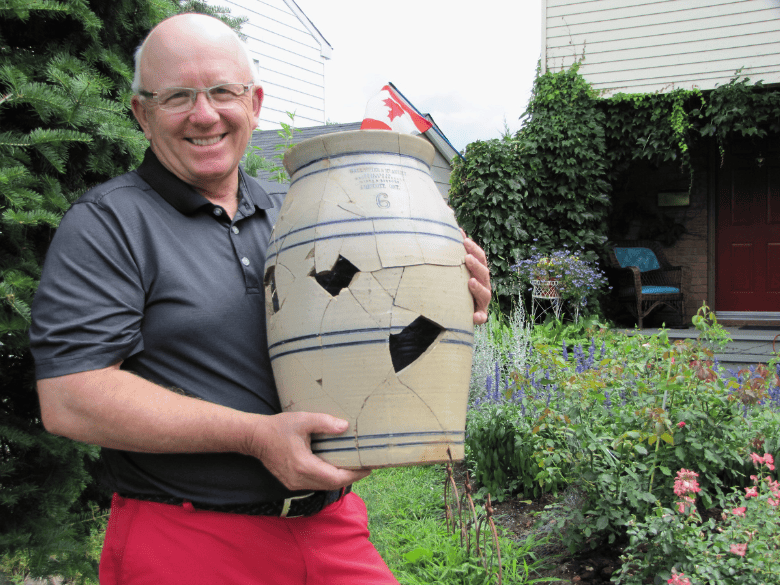
I reached down pulled it out and turned the piece over. On the front, incised in the clay, was the name “Gallagher and McCauley” a 19th century merchant in Prescott. (Having the business name stamped on the front of a piece of stoneware was a common method of advertising in 19th century Ontario.)
We quickly noticed other pieces strewn about and, on a whim, collected all the shards, put them in a box and stored them in the car. Later that day, we left the box with my mother who is a lover of any type of puzzle. It was a week later when she called to say it was ready. What had been thirty or forty dirty pieces of clay in a box was now a largely complete, majestic six-gallon butter churn!
It was that fragmented churn that started my life as an antique collector.”
If you could give your younger self a piece of advice about collecting, what would it be?
I wish I bought fewer things, but of higher quality. When you start, you have no knowledge to go on. You are lost in this ginormous field of collecting. Some collectors get next to a dealer, and they learn from the dealer. Learning from a dealer really accelerates the process. You’re still going to make mistakes, but maybe not as many. Buying higher quality is really all what it is about. You want a good collection of museum quality. It takes a lot of time to appreciate and recognize museum quality. I remember selling an incredible double-sided sign that hung on a tavern along highway two in 1782. It had “Peter’s Inn” inscribed in lovely handwritten script. That was an extremely high caliber piece that I sold too eagerly.
For new collectors, they must walk through all the excessive amount of stuff on the market today and try to find things in your scope of collecting. I recently went to a large flea market and looked at possibly 10,000 items in one day and couldn’t find one thing to buy. But that’s what collecting is all about. You have to be patient. You have to keep looking. You must keep checking in with dealers. You are always testing your knowledge against someone else. Learning to recognize quality, which is the main challenge.
Could you speak to some of the collecting principals that have guided you over the years as an antique and Folk Art Collector?
When you collect you must have boundaries. Some people have very strict boundaries, others are more flexible. If you create a tight boundary around your collecting, you pass by a lot of wonderful pieces, it is more difficult to find pieces that meet your requirements, and as a result, you will have a very small collection. The joy of collecting is the acquisition; the hunt, the research, and the joy of owning the piece. That’s where you find the energy for the whole process: in the journey.
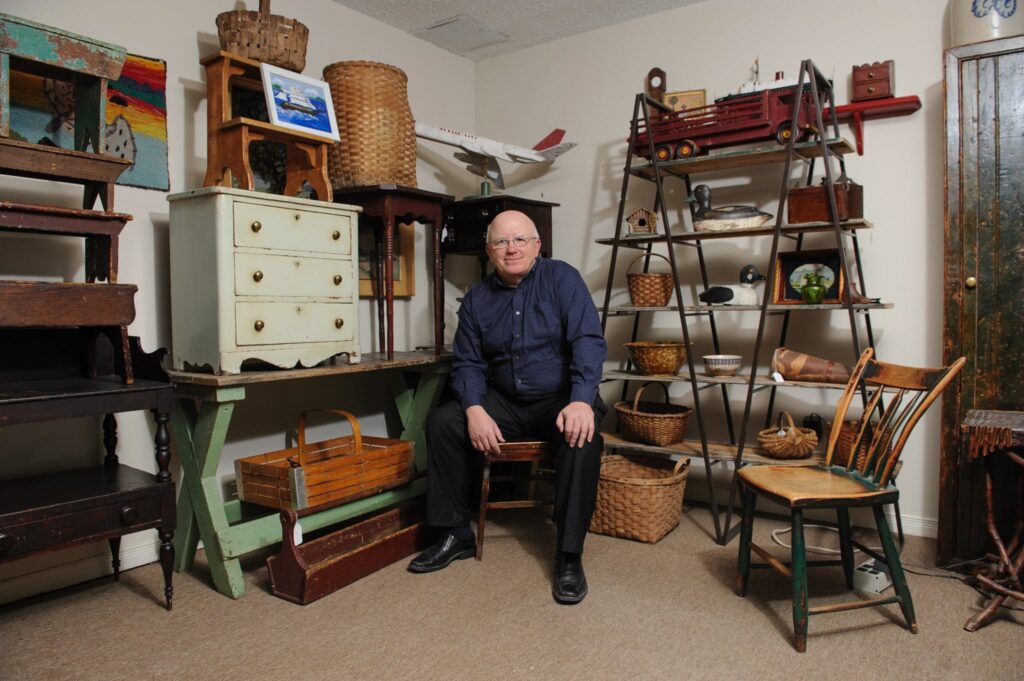
Too wide of a scope is even worse, you are buying all this material, handling a lot of pieces, and that is how you end up with piles and start stuffing it in rooms. You will hit some home runs, but you will make more mistakes. Collections have all different levels of quality. For myself, I have strict guidelines when it comes to contemporary Folk Art. The majority of contemporary Folk Art I find too commercialized. People see a Maud Lewis and think to themselves, “I could easily do that.” So, you have contemporary artists who intentionally created folk art to sell on mass. It got overdone. I don’t buy that type of Folk art, I prefer the more genuine, older folk art.
I’m not saying that all modern Folk Art is not authentic, there are some who are not as commercial as others but, for me, it is a little bit too new. I do like things to have some age. However, this does not mean I have no modern Folk Art in my collection. I have a triptych that was done in 2002, but I fell in love with the piece. The artist created genuine works that I really enjoy.
Out of the entire collection that you are bringing to market, is there a favourite?
A few things were certainly difficult to part with, its extremely tricky to narrow it down to one. Letting the two Maud Lewis go was a bit traumatic. The large Joseph Sleep painting as well, it really is a masterpiece by him. He typically did much smaller works so that tourists could fit them in their luggage for the plane or in their car. So, the piece being offered is atypical for him. It is how it goes though. We all buy to own for a little while before it moves onto the next collection.
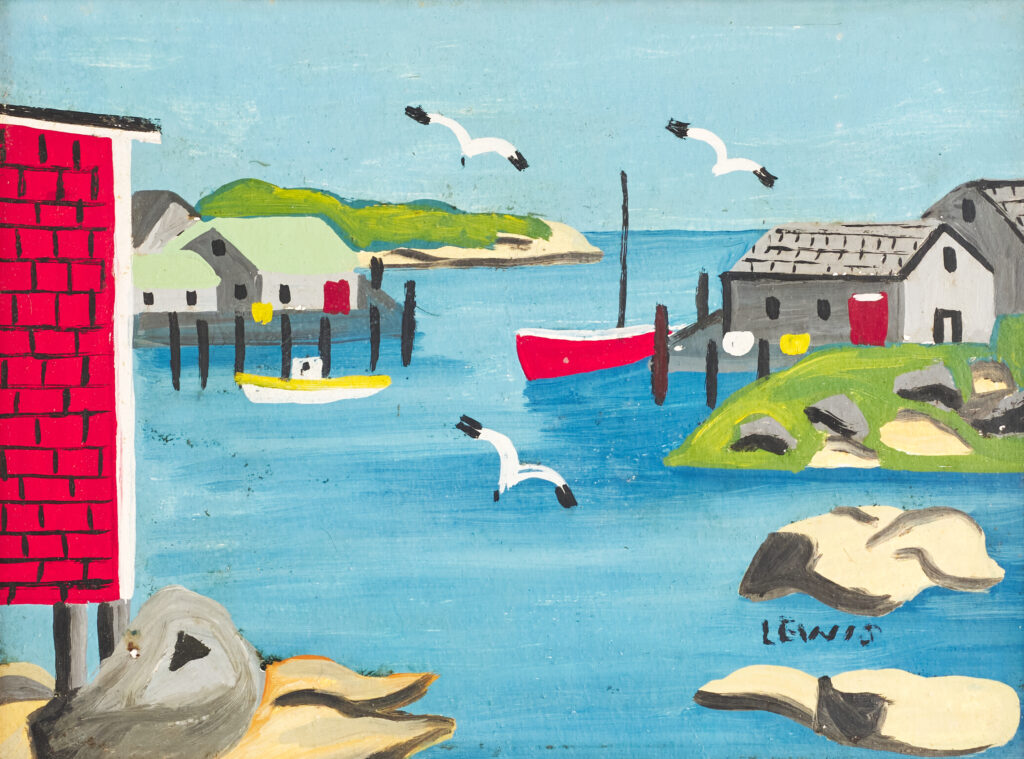
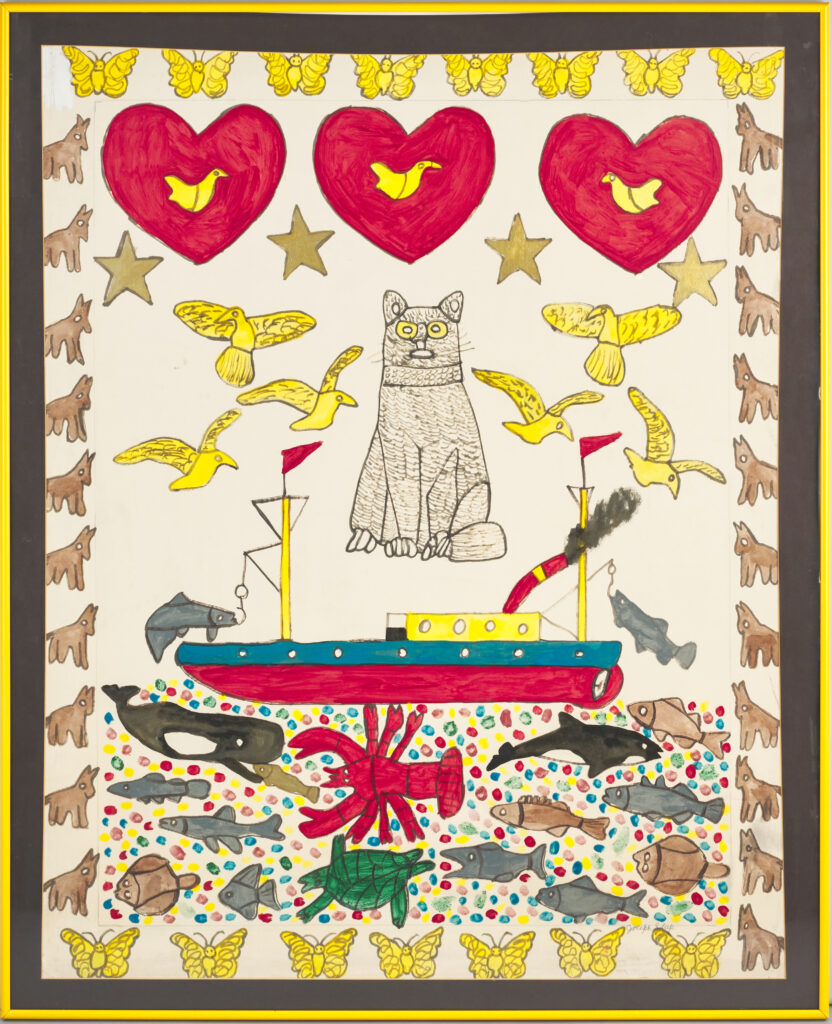

Over the years, you have sold a lot on your own, why did you choose to bring your collection to auction?
If you’re going to sell things in volume, auctions are a good way to do it. To sell two hundred and ten things yourself, you’re going to spend a lot of time online or unpacking and packing at shows or fairs. We had so much stuff, all through the last five years I bought quite a few things. So, there were so many pieces in our home. I wanted to experience the feeling of the big auction it seemed like a fun and interesting decision. If you’re going to have a sale of this type, you must have volume and quality. Even as it was two hundred and ten items, other inclusions were added as well.
As a collector, have you noticed changes in the collecting field over the past five years? If so, do you think these trends will continue?
Over the last several years, furniture has become quite soft in terms of its market value. Middle of the road quality furniture is not selling. Furniture has just been lagging because people physically don’t have the room. If you wanted to buy a stripped Canadiana cupboard, I could find you ten cupboards in a few minutes. If you want an original piece, with no repairs, in two pieces, the search will take more time.
While the furniture market has seen a lot of change, there are other areas that are continuing to exceed expectations. There is always room for another painting on the wall. Artwork continues to become stronger and stronger. Look at the pieces by Angus Trudeau, Phillipe Roy, Maud Lewis, Jean-Baptiste Côté and others are fetching. That material continues to gather strength. Decorated stoneware, redware, and pottery continues to get stronger because of the uniqueness and the rarity of the material itself. Early advertising and metal signs are doing well, and I think that will continue. I don’t see furniture recovering. Good and rare things in furniture will continue to get good prices, but there is so much material coming onto the market which results in overall dampening on price. Small things always command a premium. The only thing better is a pair of small pieces.
Final Remarks on the Shaun & Joan Markey Collection
Working with Shaun to bring this collection to market has been a pleasure. Pridham’s is honoured to auction his items on Saturday, October 21st at 10 AM EST. The sale will be live in person at our galleries in Ottawa as well as live online (via Live Auctioneers and HiBid). Two sale preview days are being held at the gallery: Thursday, October 19th and Friday, October 20th from 10 AM to 5 PM. To conclude, here is a final remark from Shaun on parting with his collection:
“We’re not selling everything. We need several pieces to stay because we use them or admire them on a daily basis. One thing I do know, is that the big butter churn from Prescott is staying at home.”



